2020-2021学年外研版(2019)选择性必修三教案:Unit3 War and peace(全单元)
文档属性
| 名称 | 2020-2021学年外研版(2019)选择性必修三教案:Unit3 War and peace(全单元) | 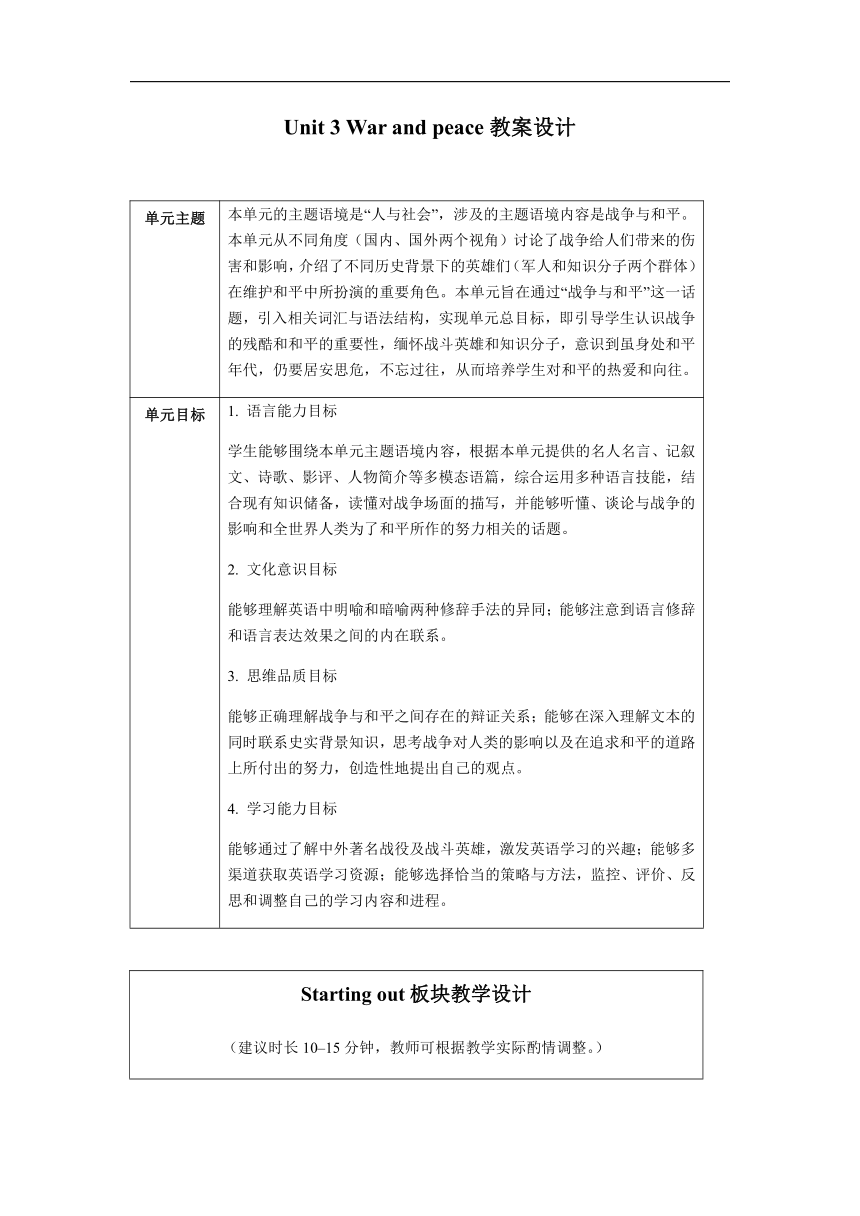 | |
| 格式 | docx | ||
| 文件大小 | 41.0KB | ||
| 资源类型 | 教案 | ||
| 版本资源 | 外研版(2019) | ||
| 科目 | 英语 | ||
| 更新时间 | 2021-01-15 22:08:04 | ||
图片预览

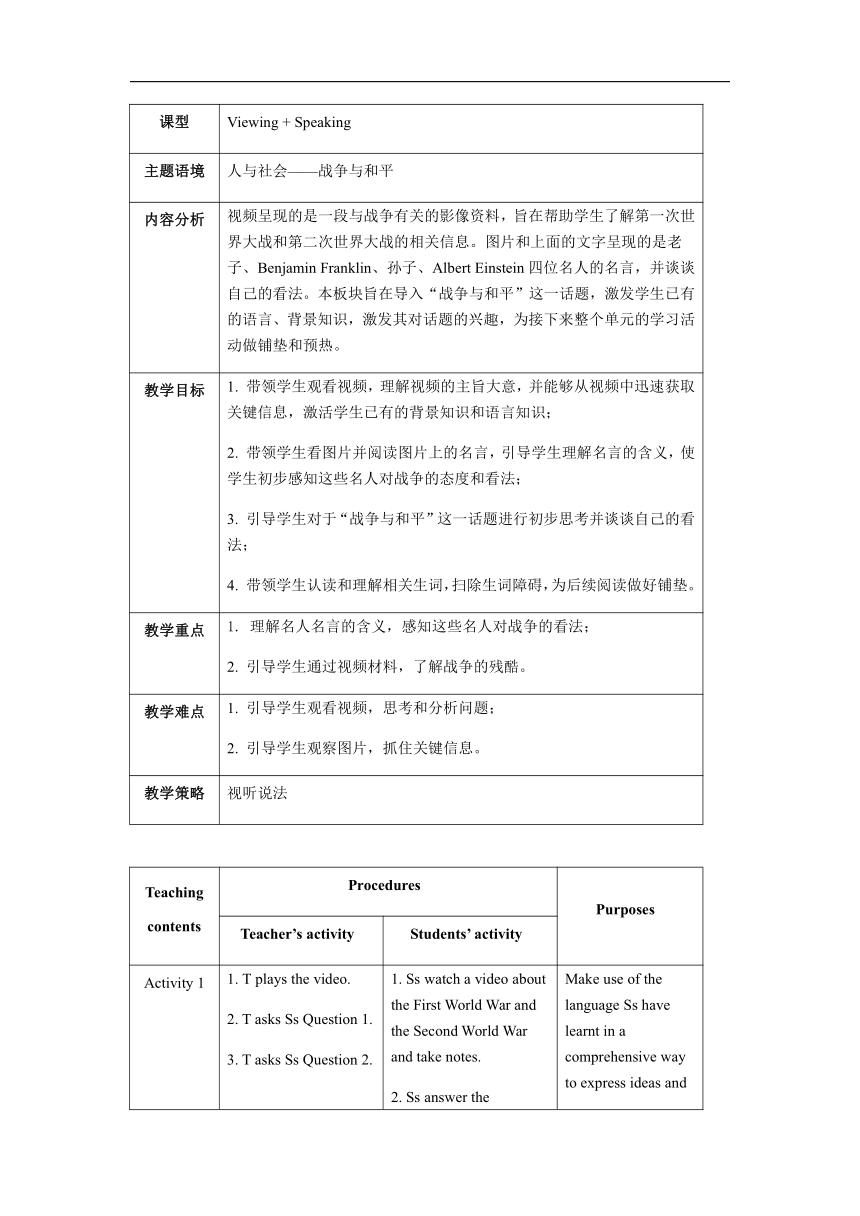
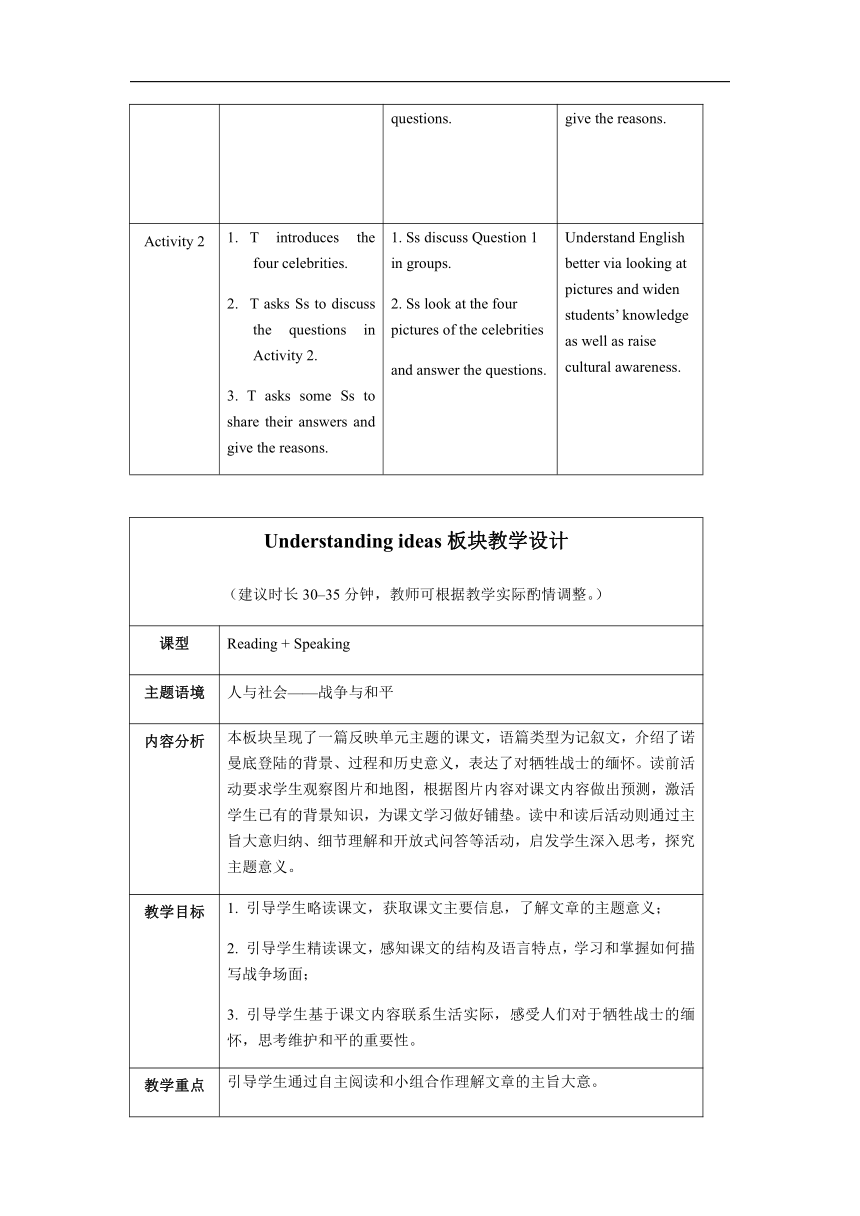
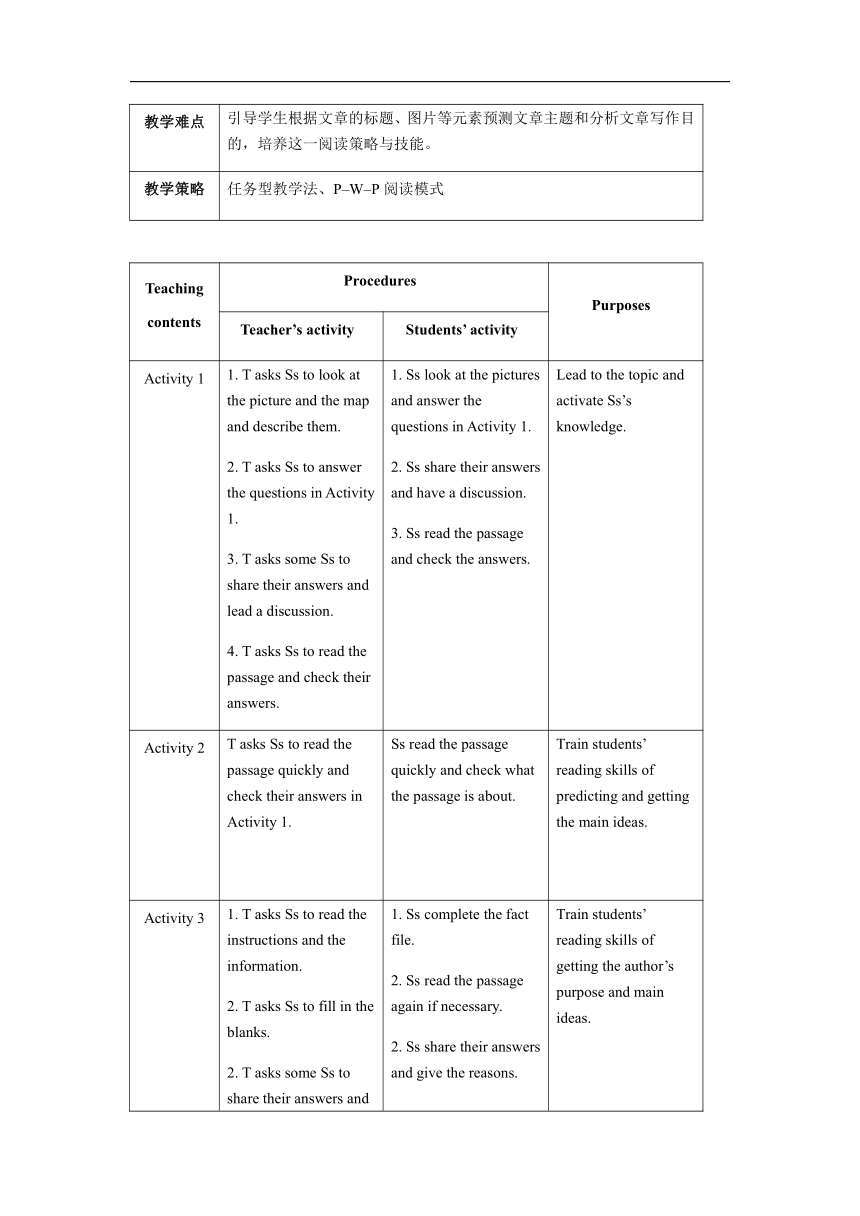
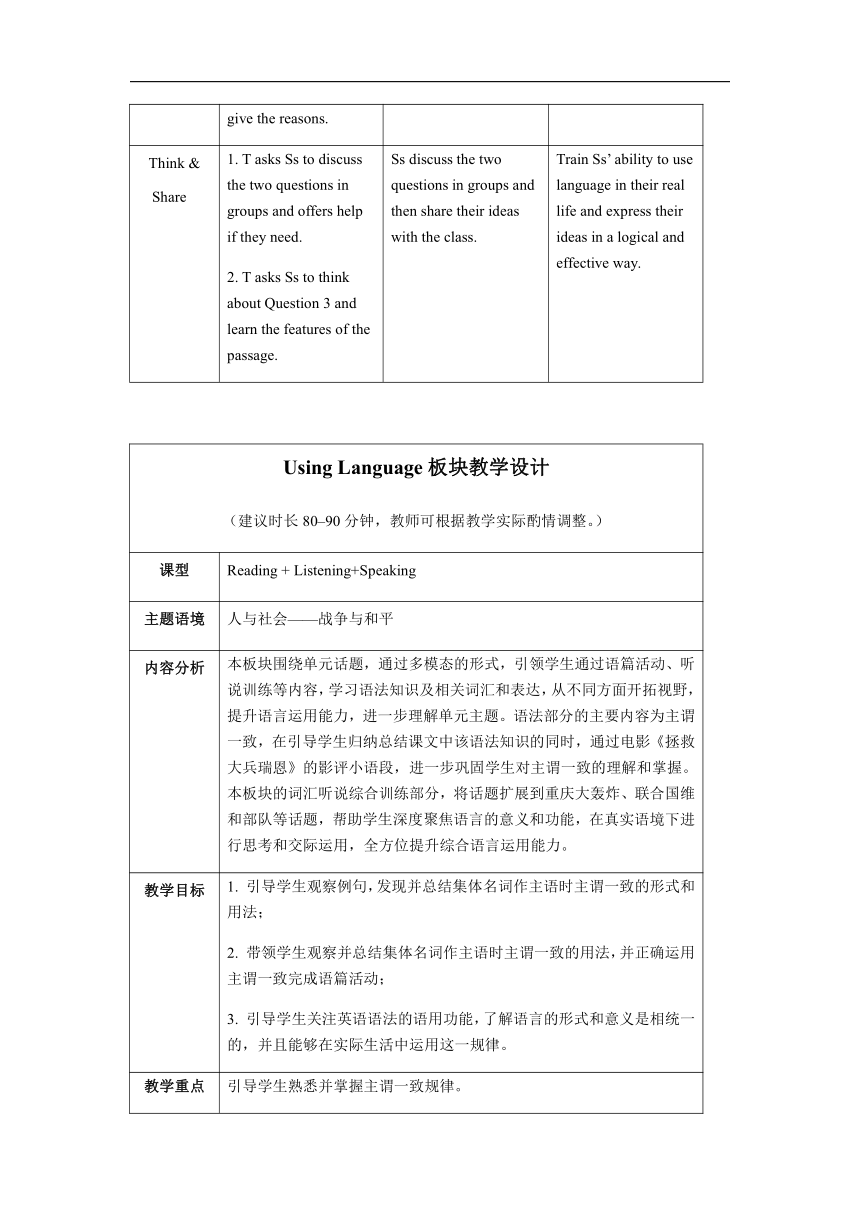
文档简介
Unit 3 War and peace教案设计
单元主题
本单元的主题语境是“人与社会”,涉及的主题语境内容是战争与和平。本单元从不同角度(国内、国外两个视角)讨论了战争给人们带来的伤害和影响,介绍了不同历史背景下的英雄们(军人和知识分子两个群体)在维护和平中所扮演的重要角色。本单元旨在通过“战争与和平”这一话题,引入相关词汇与语法结构,实现单元总目标,即引导学生认识战争的残酷和和平的重要性,缅怀战斗英雄和知识分子,意识到虽身处和平年代,仍要居安思危,不忘过往,从而培养学生对和平的热爱和向往。
单元目标
1. 语言能力目标
学生能够围绕本单元主题语境内容,根据本单元提供的名人名言、记叙文、诗歌、影评、人物简介等多模态语篇,综合运用多种语言技能,结合现有知识储备,读懂对战争场面的描写,并能够听懂、谈论与战争的影响和全世界人类为了和平所作的努力相关的话题。
2. 文化意识目标
能够理解英语中明喻和暗喻两种修辞手法的异同;能够注意到语言修辞和语言表达效果之间的内在联系。
3. 思维品质目标
能够正确理解战争与和平之间存在的辩证关系;能够在深入理解文本的同时联系史实背景知识,思考战争对人类的影响以及在追求和平的道路上所付出的努力,创造性地提出自己的观点。
4. 学习能力目标
能够通过了解中外著名战役及战斗英雄,激发英语学习的兴趣;能够多渠道获取英语学习资源;能够选择恰当的策略与方法,监控、评价、反思和调整自己的学习内容和进程。
Starting out板块教学设计
(建议时长10–15分钟,教师可根据教学实际酌情调整。)
课型
Viewing + Speaking
主题语境
人与社会——战争与和平
内容分析
视频呈现的是一段与战争有关的影像资料,旨在帮助学生了解第一次世界大战和第二次世界大战的相关信息。图片和上面的文字呈现的是老子、Benjamin Franklin、孙子、Albert Einstein四位名人的名言,并谈谈自己的看法。本板块旨在导入“战争与和平”这一话题,激发学生已有的语言、背景知识,激发其对话题的兴趣,为接下来整个单元的学习活动做铺垫和预热。
教学目标
1. 带领学生观看视频,理解视频的主旨大意,并能够从视频中迅速获取关键信息,激活学生已有的背景知识和语言知识;
2. 带领学生看图片并阅读图片上的名言,引导学生理解名言的含义,使学生初步感知这些名人对战争的态度和看法;
3. 引导学生对于“战争与和平”这一话题进行初步思考并谈谈自己的看法;
4. 带领学生认读和理解相关生词,扫除生词障碍,为后续阅读做好铺垫。
教学重点
1. 理解名人名言的含义,感知这些名人对战争的看法;
2. 引导学生通过视频材料,了解战争的残酷。
教学难点
1. 引导学生观看视频,思考和分析问题;
2. 引导学生观察图片,抓住关键信息。
教学策略
视听说法
Teaching contents
Procedures
Purposes
Teacher’s activity
Students’ activity
Activity 1
1. T plays the video.
2. T asks Ss Question 1.
3. T asks Ss Question 2.
1. Ss watch a video about the First World War and the Second World War and take notes.
2. Ss answer the questions.
Make use of the language Ss have learnt in a comprehensive way to express ideas and give the reasons.
Activity 2
T introduces the four celebrities.
T asks Ss to discuss the questions in Activity 2.
3. T asks some Ss to share their answers and give the reasons.
1. Ss discuss Question 1 in groups.
2. Ss look at the four pictures of the celebrities
and answer the questions.
Understand English better via looking at pictures and widen students’ knowledge as well as raise cultural awareness.
Understanding ideas板块教学设计
(建议时长30–35分钟,教师可根据教学实际酌情调整。)
课型
Reading + Speaking
主题语境
人与社会——战争与和平
内容分析
本板块呈现了一篇反映单元主题的课文,语篇类型为记叙文,介绍了诺曼底登陆的背景、过程和历史意义,表达了对牺牲战士的缅怀。读前活动要求学生观察图片和地图,根据图片内容对课文内容做出预测,激活学生已有的背景知识,为课文学习做好铺垫。读中和读后活动则通过主旨大意归纳、细节理解和开放式问答等活动,启发学生深入思考,探究主题意义。
教学目标
1. 引导学生略读课文,获取课文主要信息,了解文章的主题意义;
2. 引导学生精读课文,感知课文的结构及语言特点,学习和掌握如何描写战争场面;
3. 引导学生基于课文内容联系生活实际,感受人们对于牺牲战士的缅怀,思考维护和平的重要性。
教学重点
引导学生通过自主阅读和小组合作理解文章的主旨大意。
教学难点
引导学生根据文章的标题、图片等元素预测文章主题和分析文章写作目的,培养这一阅读策略与技能。
教学策略
任务型教学法、P–W–P阅读模式
Teaching contents
Procedures
Purposes
Teacher’s activity
Students’ activity
Activity 1
1. T asks Ss to look at the picture and the map and describe them.
2. T asks Ss to answer the questions in Activity 1.
3. T asks some Ss to share their answers and lead a discussion.
4. T asks Ss to read the passage and check their answers.
1. Ss look at the pictures and answer the questions in Activity 1.
2. Ss share their answers and have a discussion.
3. Ss read the passage and check the answers.
Lead to the topic and activate Ss’s knowledge.
Activity 2
T asks Ss to read the passage quickly and check their answers in Activity 1.
Ss read the passage quickly and check what the passage is about.
Train students’ reading skills of predicting and getting the main ideas.
Activity 3
1. T asks Ss to read the instructions and the information.
2. T asks Ss to fill in the blanks.
2. T asks some Ss to share their answers and give the reasons.
1. Ss complete the fact file.
2. Ss read the passage again if necessary.
2. Ss share their answers and give the reasons.
Train students’ reading skills of getting the author’s purpose and main ideas.
Think & Share
1. T asks Ss to discuss the two questions in groups and offers help if they need.
2. T asks Ss to think about Question 3 and learn the features of the passage.
Ss discuss the two questions in groups and then share their ideas with the class.
Train Ss’ ability to use language in their real life and express their ideas in a logical and effective way.
Using Language板块教学设计
(建议时长80–90分钟,教师可根据教学实际酌情调整。)
课型
Reading + Listening+Speaking
主题语境
人与社会——战争与和平
内容分析
本板块围绕单元话题,通过多模态的形式,引领学生通过语篇活动、听说训练等内容,学习语法知识及相关词汇和表达,从不同方面开拓视野,提升语言运用能力,进一步理解单元主题。语法部分的主要内容为主谓一致,在引导学生归纳总结课文中该语法知识的同时,通过电影《拯救大兵瑞恩》的影评小语段,进一步巩固学生对主谓一致的理解和掌握。本板块的词汇听说综合训练部分,将话题扩展到重庆大轰炸、联合国维和部队等话题,帮助学生深度聚焦语言的意义和功能,在真实语境下进行思考和交际运用,全方位提升综合语言运用能力。
教学目标
1. 引导学生观察例句,发现并总结集体名词作主语时主谓一致的形式和用法;
2. 带领学生观察并总结集体名词作主语时主谓一致的用法,并正确运用主谓一致完成语篇活动;
3. 引导学生关注英语语法的语用功能,了解语言的形式和意义是相统一的,并且能够在实际生活中运用这一规律。
教学重点
引导学生熟悉并掌握主谓一致规律。
教学难点
引导学生关注英语语法的表意功能,使学生意识到语法规则是为表意功能服务的。
教学策略
交际教学法、任务型教学法
Teaching contents
Procedures
Purposes
Teacher’s activity
Students’ activity
Activity 1
1. T asks Ss to read the sentences and answer Questions 1 and 2.
2. T helps Ss to conclude the usage of subject-verb agreement and use it to complete the short passage.
3. T asks Ss to read
Sentence c again and discuss verb’s forms with “people” being the subject.
4. T asks some Ss to share their answers and give reasons.
1. Ss read the sentences and focus on the bald words.
2. Ss answer Questions 1 and 2.
3. Ss conclude the usage of subject-verb agreement.
4. Ss read the passage again and find more examples of subject-verb agreement.
Find and summarise the forms and usage of subject-verb agreement.
Activity 2
1. T asks Ss to read the sentences in Activity 2 and get the main idea.
2. T asks some Ss to share their answers and give reasons.
1. Ss read the sentences and identify whether the sentences are correct in subject-verb agreement.
Use language in the real situation.
Activity 3
1. T asks Ss to read the film review and complete it with the correct form of the verbs .
1. Ss read the passage and get the main idea.
2. Ss complete the film review with the correct form of the given verbs.
Get a better understanding of subject-verb agreement and know how to write a film review.
Activity 4
1. T asks Ss to recall films on the theme of war and peace.
2. T asks Ss to read the passage in Activity 3 and focus on the structure, content and subject-verb agreement.
3. T divides Ss into groups and leads them to write a film review in groups.
3. T asks Ss to share the best film review and give comments.
1. Ss give information about the films on war and peace.
2. Ss write film reviews in groups.
3. Ss select the best film review in groups and share it.
Practise subject-verb agreement and learn how to write a film review.
Activity 5
T asks Ss to read the short passage in “Did you know?” on Page 30 and learn the background information about Chongqing bombing.
Ss read the short passage on Page30 and learn the background information about Chongqing bombing.
Know historical background information.
Activity 6
1. T asks Ss to look through the notes in Activity 6 and know the key points before listening and play the audio.
2. T plays the audio again and asks some Ss to share the answers.
1. Ss listen for the first time and fill in the blanks.
2. Ss listen for the second time and check their answers.
Train the listening skills of getting the key points in listening.
Activity 7
1. T leads Ss to collect expressions expressing sympathy and talk about memories.
1. Ss listen to the recording and comprehend the expressions.
2. Ss complete the boxes.
3. Ss share their answers.
4. Ss make sentences with expressions in the boxes.
Learn how to express sympathy and talk about memories.
Activity 8
1. T asks Ss to read the passage.
2. T helps Ss learn the significance of UN peacekeeping.
1. Ss read the passage and get the main idea.
2. Ss guess the meaning of the words in bold.
3. Ss discuss the answers in groups.
4. Ss share their answers.
Guess the meaning of a new word according to the context and know more about the UN peacekeeping.
Activity 9
1. T asks Ss to read the fact file to get the general idea.
2. T asks Ss to complete the fact file with the correct form of the words and expressions in Activity 8.
1. Ss read the fact file to get the general idea.
2. Ss complete the fact file with the correct form of the words and expressions in Activity 8.
Let Ss be more familiar with the words and expressions in Acitivity 8.
Developing ideas板块教学设计
(建议时长80–90分钟,教师可根据教学实际酌情调整。)
课型
Reading + Writing
主题语境
人与社会——战争与和平
内容分析
本板块从另一角度呈现一篇体现单元主题的课文,语篇类型为记叙文,介绍了诞生于抗日战争时期的西南联大,并从多个角度叙述了联大的历史。读写部分的范文介绍了一位杰出的抗日英雄——杨靖宇,旨在引导学生通过学习范文,了解英雄的感人事迹和优秀品质,同时帮助学生学会如何写简介介绍一位战斗英雄。通过这一板块的学习,学生能够加深对主题意义的理解,弘扬传统文化,树立民族自信,进一步提升语言能力和思维品质。
教学目标
1. 引导学生通过阅读课文,理解课文内容并了解联大的成立背景和重要历史意义,同时能够理解并运用明喻和暗喻描述事物的鲜明特征;
2. 引导学生在理解课文内容的基础上,感悟文章主题,加深对单元主题意义的认识,形成对战争残酷性的认识,从英雄身上汲取精神财富,培养爱国情操;
3. 引导学生通过学习范文的写作手法和特点,写一篇战斗英雄的简介。
教学重点
引导学生读懂文章,了解联大建立的历史和历史意义,挖掘战争的另一面意义。
教学难点
引导学生注重语言在思维层面的内化和输出。
教学策略
交际教学法、任务型教学法
Teaching contents
Procedures
Purposes
Teacher’s activity
Students’ activity
Activity 1
1. T asks Ss to look at the two pictures so as to activate their knowledge of National Southwest Associated University.
2. T invites some Ss to discuss Questions 1 and 2 in groups.
3. T asks Ss to think about the differences between Lianda and today’s universities.
4. T asks some students to share their answers and give reasons.
5. T asks the class to read the passage and find more differences between Lianda and today’s universities.
1. Ss look at the two pictures and try to find the name of the university in the first picture.
2. Ss talk about the differences between the university in the pictures and today’s universities.
3. Ss share their answers and give reasons.
4. Ss read the passage and find more differences between Lianda and today’s universities.
Lead to the topic and activate Ss’ background knowledge.
Activity 2
1. T invites Ss to read the passage again and choose the ideas conveyed in the passage and find evidence to support their choices.
2. T asks Ss to share their answers.
1. Ss read the passage again and choose the ideas conveyed in the passage and find evidence.
2. Ss share their answers.
Understand the ideas the writer wants to convey.
Activity 3
1. T asks Ss to read the content in “Learning to learn” part and get the differences between similes and metaphors.
2. T leads Ss to find out what figures of speech are used in the sentences and discuss how they
help to express the author’s emotions.
1. Ss read “Learning to learn” and find out the differences between similes and metaphors.
2. Ss find out what figures of speech are used in the two sentences and discuss how they help to express the author’s emotions.
Help Ss understand different figures of speech in English.
Think & Share
1. T asks Ss to discuss the four questions in “Think and Share”.
2. T invites some Ss to share their opinions.
Ss discuss the four questions in groups and then share their opinions with the class.
Deepen Ss’ understanding of the passage and figures of speech in English.
Activity 4
1. T helps Ss understand the requirement of Activity 4.
2. T helps Ss answer the three questions and invites Ss to share their answers.
3. T asks Ss to complete the diagram.
4. T helps Ss give a talk about the spirit of Lianda.
1. Ss read the requirement of Activity 4.
2. Ss answer the three questions and share their answers.
3. Ss complete the diagram.
4. Ss give a talk about the spirit of Lianda.
Consolidate the content learnt and improve oral expressions.
Activity 5
T guides Ss to read the introduction to Yang Jingyu and answer the four questions.
Ss read the passage and answer the questions.
Extract and summarise the information and know the story of Yang Jingyu.
Activity 6-7
1. T asks Ss to share information they know about other war heroes.
2. T asks Ss to choose one hero to write about.
3. T helps Ss organise ideas by completing the notes below.
4. T leads Ss to give comments on their writing in pairs.
5. T invites some Ss to share their writing.
1. Ss share information about other war heroes.
2. Ss choose one hero to write about.
3. Ss organise their ideas by completing the notes.
4. Ss give comments on each other’s writing in pairs.
5. Ss share their writing.
Practise writing an introduction to a war hero with the help of the notes.
Presenting ideas & Reflection板块教学设计
(Presenting ideas和Reflection部分建议时长80–90分钟,
教师可根据教学实际酌情调整。)
课型
Speaking
主题语境
人与社会——战争与和平
内容分析
本板块要求学生通过观察图片,认识战争的残酷和给人类带来的痛苦,然后思考与战争相关的三个话题,并进行详细的解读。在此基础上,教师引导学生选择一个话题,并通过演讲的方式表达自己的观点。本板块旨在通过内容和观点阐述,促使学生复习并巩固所学内容,在真实的情境中加以运用和实践。
教学目标
1. 引导学生通过本单元的学习,深入地理解战争的残酷和给人类带来的痛苦;
2. 引导学生通过本单元的学习,选择与单元主题相关的话题发表演讲,对“战争与和平”这一主题有更深入的理解;
3. 培养学生的小组合作意识,学会通过信息互换,扩大自己的知识储备量。
教学重点
1. 引导学生根据单元所学内容,对战争形成全面的认识;
2. 引导学生从语言能力、思维品质等方面对自己在学习本单元后的效果做出合理的评价。
教学难点
1. 指导学生使用本板块中的实用表达,加强演讲的表现力。
2. 引导学生养成自我评价的良好学习习惯。
教学策略
元认知策略、认知策略、交际策略和情感策略
Teaching contents
Procedures
Purposes
Teacher’s activity
Students’ activity
Activity 1
1. T asks Ss to look at the pictures in groups and answer Question 1.
2. T asks Ss to answer Question 2 according to the answers to Questions 1.
3. T invites some Ss to share their answers and gives help when necessary.
1. Ss look at the pictures and answer Question 1.
2. Ss answer Question 2.
3. Ss share their answers.
Generate new ideas and prepare for the presentation.
Activity 2-4
1. T leads Ss to think about the three topics in Activity 2 and complete the table.
2.T helps Ss prepare a short presentation on one of the topics from Activity 2 or think of
another relevant topic.
1. Ss think about the three topics.
2. Ss choose a topic and prepare a short presentation in groups.
3. Ss make a presentation in class.
Organise presentation in groups.
Reflection
1. T guides Ss to recall what theyhave learnt in this unit.
2. T asks Ss to complete “Reflection” on P36.
Ss rate their performance in this unit, summarise what theyhave learnt and think about what they need to improve.
Review, rate performance and think about ways to improve.
Project板块教学设计
(此部分教师可根据教学实际酌情调整。)
课型
Speaking
主题语境
人与社会——战争与和平
内容分析
本单元的项目实践活动要求学生以“战争与和平”为话题发表演讲。教师引导学生通过自主学习、合作学习、探究式学习,培养学生的调研与动手能力,让学生对单元主题作进一步的延伸和探索。
教学目标
1. 引导学生通过在图书馆查阅或网上搜索等途径开展调研,搜集人类历史上著名的以“战争与和平”为主题的演讲;
2. 引导学生通过多种途径查询相关信息,开展合作探究,提升沟通、协作能力;
3. 引导学生通过准备演讲,将学习与实际相结合,提高调研、沟通能力;
4. 引导学生珍惜来之不易的幸福生活,培养对和平的热爱。
教学重点
1. 引导学生利用单元所学,了解和掌握调研的方法和技巧,用英语思维想事情;
2. 确定分组,完善小组内分工,为课堂活动做好准备。
教学难点
引导学生分组进行调研,全班进行评价并给出修改建议。
教学策略
任务型教学法
Teaching contents
Procedures
Purposes
Teacher’s activity
Students’ activity
Investigate
1. T divides the class into 4-6 groups and asks them to do research online or in the library.
2. T asks Ss to choose one to study.
1. Ss work in groups and do the research.
2. Ss choose one speech to study.
Develop skills of searching information.
Plan
1. T asks some Ss to share the speech they have found and identify
useful words, expressions, structures and other features.
2. T leads Ss to think of events during wartime that would be suitable for a speech.
1. Ss share what theyhave found and identify the useful expressions, structures and other features.
2. Ss work in groups and think of wartime events that suit the speech.
Language and relative material accumulation.
Create
T helps Ss write and rehearse the speech.
Ss work in groups to write and rehearse the speech.
Put the knowledge they have learnt into practice.
Present
T arranges the time for Ss to deliver the speech.
1. Ss select a representative from the group to deliver the speech to the class.
2. Ss vote for the best speaker.
Practise skills in giving a presentation, and learn from each other.
单元主题
本单元的主题语境是“人与社会”,涉及的主题语境内容是战争与和平。本单元从不同角度(国内、国外两个视角)讨论了战争给人们带来的伤害和影响,介绍了不同历史背景下的英雄们(军人和知识分子两个群体)在维护和平中所扮演的重要角色。本单元旨在通过“战争与和平”这一话题,引入相关词汇与语法结构,实现单元总目标,即引导学生认识战争的残酷和和平的重要性,缅怀战斗英雄和知识分子,意识到虽身处和平年代,仍要居安思危,不忘过往,从而培养学生对和平的热爱和向往。
单元目标
1. 语言能力目标
学生能够围绕本单元主题语境内容,根据本单元提供的名人名言、记叙文、诗歌、影评、人物简介等多模态语篇,综合运用多种语言技能,结合现有知识储备,读懂对战争场面的描写,并能够听懂、谈论与战争的影响和全世界人类为了和平所作的努力相关的话题。
2. 文化意识目标
能够理解英语中明喻和暗喻两种修辞手法的异同;能够注意到语言修辞和语言表达效果之间的内在联系。
3. 思维品质目标
能够正确理解战争与和平之间存在的辩证关系;能够在深入理解文本的同时联系史实背景知识,思考战争对人类的影响以及在追求和平的道路上所付出的努力,创造性地提出自己的观点。
4. 学习能力目标
能够通过了解中外著名战役及战斗英雄,激发英语学习的兴趣;能够多渠道获取英语学习资源;能够选择恰当的策略与方法,监控、评价、反思和调整自己的学习内容和进程。
Starting out板块教学设计
(建议时长10–15分钟,教师可根据教学实际酌情调整。)
课型
Viewing + Speaking
主题语境
人与社会——战争与和平
内容分析
视频呈现的是一段与战争有关的影像资料,旨在帮助学生了解第一次世界大战和第二次世界大战的相关信息。图片和上面的文字呈现的是老子、Benjamin Franklin、孙子、Albert Einstein四位名人的名言,并谈谈自己的看法。本板块旨在导入“战争与和平”这一话题,激发学生已有的语言、背景知识,激发其对话题的兴趣,为接下来整个单元的学习活动做铺垫和预热。
教学目标
1. 带领学生观看视频,理解视频的主旨大意,并能够从视频中迅速获取关键信息,激活学生已有的背景知识和语言知识;
2. 带领学生看图片并阅读图片上的名言,引导学生理解名言的含义,使学生初步感知这些名人对战争的态度和看法;
3. 引导学生对于“战争与和平”这一话题进行初步思考并谈谈自己的看法;
4. 带领学生认读和理解相关生词,扫除生词障碍,为后续阅读做好铺垫。
教学重点
1. 理解名人名言的含义,感知这些名人对战争的看法;
2. 引导学生通过视频材料,了解战争的残酷。
教学难点
1. 引导学生观看视频,思考和分析问题;
2. 引导学生观察图片,抓住关键信息。
教学策略
视听说法
Teaching contents
Procedures
Purposes
Teacher’s activity
Students’ activity
Activity 1
1. T plays the video.
2. T asks Ss Question 1.
3. T asks Ss Question 2.
1. Ss watch a video about the First World War and the Second World War and take notes.
2. Ss answer the questions.
Make use of the language Ss have learnt in a comprehensive way to express ideas and give the reasons.
Activity 2
T introduces the four celebrities.
T asks Ss to discuss the questions in Activity 2.
3. T asks some Ss to share their answers and give the reasons.
1. Ss discuss Question 1 in groups.
2. Ss look at the four pictures of the celebrities
and answer the questions.
Understand English better via looking at pictures and widen students’ knowledge as well as raise cultural awareness.
Understanding ideas板块教学设计
(建议时长30–35分钟,教师可根据教学实际酌情调整。)
课型
Reading + Speaking
主题语境
人与社会——战争与和平
内容分析
本板块呈现了一篇反映单元主题的课文,语篇类型为记叙文,介绍了诺曼底登陆的背景、过程和历史意义,表达了对牺牲战士的缅怀。读前活动要求学生观察图片和地图,根据图片内容对课文内容做出预测,激活学生已有的背景知识,为课文学习做好铺垫。读中和读后活动则通过主旨大意归纳、细节理解和开放式问答等活动,启发学生深入思考,探究主题意义。
教学目标
1. 引导学生略读课文,获取课文主要信息,了解文章的主题意义;
2. 引导学生精读课文,感知课文的结构及语言特点,学习和掌握如何描写战争场面;
3. 引导学生基于课文内容联系生活实际,感受人们对于牺牲战士的缅怀,思考维护和平的重要性。
教学重点
引导学生通过自主阅读和小组合作理解文章的主旨大意。
教学难点
引导学生根据文章的标题、图片等元素预测文章主题和分析文章写作目的,培养这一阅读策略与技能。
教学策略
任务型教学法、P–W–P阅读模式
Teaching contents
Procedures
Purposes
Teacher’s activity
Students’ activity
Activity 1
1. T asks Ss to look at the picture and the map and describe them.
2. T asks Ss to answer the questions in Activity 1.
3. T asks some Ss to share their answers and lead a discussion.
4. T asks Ss to read the passage and check their answers.
1. Ss look at the pictures and answer the questions in Activity 1.
2. Ss share their answers and have a discussion.
3. Ss read the passage and check the answers.
Lead to the topic and activate Ss’s knowledge.
Activity 2
T asks Ss to read the passage quickly and check their answers in Activity 1.
Ss read the passage quickly and check what the passage is about.
Train students’ reading skills of predicting and getting the main ideas.
Activity 3
1. T asks Ss to read the instructions and the information.
2. T asks Ss to fill in the blanks.
2. T asks some Ss to share their answers and give the reasons.
1. Ss complete the fact file.
2. Ss read the passage again if necessary.
2. Ss share their answers and give the reasons.
Train students’ reading skills of getting the author’s purpose and main ideas.
Think & Share
1. T asks Ss to discuss the two questions in groups and offers help if they need.
2. T asks Ss to think about Question 3 and learn the features of the passage.
Ss discuss the two questions in groups and then share their ideas with the class.
Train Ss’ ability to use language in their real life and express their ideas in a logical and effective way.
Using Language板块教学设计
(建议时长80–90分钟,教师可根据教学实际酌情调整。)
课型
Reading + Listening+Speaking
主题语境
人与社会——战争与和平
内容分析
本板块围绕单元话题,通过多模态的形式,引领学生通过语篇活动、听说训练等内容,学习语法知识及相关词汇和表达,从不同方面开拓视野,提升语言运用能力,进一步理解单元主题。语法部分的主要内容为主谓一致,在引导学生归纳总结课文中该语法知识的同时,通过电影《拯救大兵瑞恩》的影评小语段,进一步巩固学生对主谓一致的理解和掌握。本板块的词汇听说综合训练部分,将话题扩展到重庆大轰炸、联合国维和部队等话题,帮助学生深度聚焦语言的意义和功能,在真实语境下进行思考和交际运用,全方位提升综合语言运用能力。
教学目标
1. 引导学生观察例句,发现并总结集体名词作主语时主谓一致的形式和用法;
2. 带领学生观察并总结集体名词作主语时主谓一致的用法,并正确运用主谓一致完成语篇活动;
3. 引导学生关注英语语法的语用功能,了解语言的形式和意义是相统一的,并且能够在实际生活中运用这一规律。
教学重点
引导学生熟悉并掌握主谓一致规律。
教学难点
引导学生关注英语语法的表意功能,使学生意识到语法规则是为表意功能服务的。
教学策略
交际教学法、任务型教学法
Teaching contents
Procedures
Purposes
Teacher’s activity
Students’ activity
Activity 1
1. T asks Ss to read the sentences and answer Questions 1 and 2.
2. T helps Ss to conclude the usage of subject-verb agreement and use it to complete the short passage.
3. T asks Ss to read
Sentence c again and discuss verb’s forms with “people” being the subject.
4. T asks some Ss to share their answers and give reasons.
1. Ss read the sentences and focus on the bald words.
2. Ss answer Questions 1 and 2.
3. Ss conclude the usage of subject-verb agreement.
4. Ss read the passage again and find more examples of subject-verb agreement.
Find and summarise the forms and usage of subject-verb agreement.
Activity 2
1. T asks Ss to read the sentences in Activity 2 and get the main idea.
2. T asks some Ss to share their answers and give reasons.
1. Ss read the sentences and identify whether the sentences are correct in subject-verb agreement.
Use language in the real situation.
Activity 3
1. T asks Ss to read the film review and complete it with the correct form of the verbs .
1. Ss read the passage and get the main idea.
2. Ss complete the film review with the correct form of the given verbs.
Get a better understanding of subject-verb agreement and know how to write a film review.
Activity 4
1. T asks Ss to recall films on the theme of war and peace.
2. T asks Ss to read the passage in Activity 3 and focus on the structure, content and subject-verb agreement.
3. T divides Ss into groups and leads them to write a film review in groups.
3. T asks Ss to share the best film review and give comments.
1. Ss give information about the films on war and peace.
2. Ss write film reviews in groups.
3. Ss select the best film review in groups and share it.
Practise subject-verb agreement and learn how to write a film review.
Activity 5
T asks Ss to read the short passage in “Did you know?” on Page 30 and learn the background information about Chongqing bombing.
Ss read the short passage on Page30 and learn the background information about Chongqing bombing.
Know historical background information.
Activity 6
1. T asks Ss to look through the notes in Activity 6 and know the key points before listening and play the audio.
2. T plays the audio again and asks some Ss to share the answers.
1. Ss listen for the first time and fill in the blanks.
2. Ss listen for the second time and check their answers.
Train the listening skills of getting the key points in listening.
Activity 7
1. T leads Ss to collect expressions expressing sympathy and talk about memories.
1. Ss listen to the recording and comprehend the expressions.
2. Ss complete the boxes.
3. Ss share their answers.
4. Ss make sentences with expressions in the boxes.
Learn how to express sympathy and talk about memories.
Activity 8
1. T asks Ss to read the passage.
2. T helps Ss learn the significance of UN peacekeeping.
1. Ss read the passage and get the main idea.
2. Ss guess the meaning of the words in bold.
3. Ss discuss the answers in groups.
4. Ss share their answers.
Guess the meaning of a new word according to the context and know more about the UN peacekeeping.
Activity 9
1. T asks Ss to read the fact file to get the general idea.
2. T asks Ss to complete the fact file with the correct form of the words and expressions in Activity 8.
1. Ss read the fact file to get the general idea.
2. Ss complete the fact file with the correct form of the words and expressions in Activity 8.
Let Ss be more familiar with the words and expressions in Acitivity 8.
Developing ideas板块教学设计
(建议时长80–90分钟,教师可根据教学实际酌情调整。)
课型
Reading + Writing
主题语境
人与社会——战争与和平
内容分析
本板块从另一角度呈现一篇体现单元主题的课文,语篇类型为记叙文,介绍了诞生于抗日战争时期的西南联大,并从多个角度叙述了联大的历史。读写部分的范文介绍了一位杰出的抗日英雄——杨靖宇,旨在引导学生通过学习范文,了解英雄的感人事迹和优秀品质,同时帮助学生学会如何写简介介绍一位战斗英雄。通过这一板块的学习,学生能够加深对主题意义的理解,弘扬传统文化,树立民族自信,进一步提升语言能力和思维品质。
教学目标
1. 引导学生通过阅读课文,理解课文内容并了解联大的成立背景和重要历史意义,同时能够理解并运用明喻和暗喻描述事物的鲜明特征;
2. 引导学生在理解课文内容的基础上,感悟文章主题,加深对单元主题意义的认识,形成对战争残酷性的认识,从英雄身上汲取精神财富,培养爱国情操;
3. 引导学生通过学习范文的写作手法和特点,写一篇战斗英雄的简介。
教学重点
引导学生读懂文章,了解联大建立的历史和历史意义,挖掘战争的另一面意义。
教学难点
引导学生注重语言在思维层面的内化和输出。
教学策略
交际教学法、任务型教学法
Teaching contents
Procedures
Purposes
Teacher’s activity
Students’ activity
Activity 1
1. T asks Ss to look at the two pictures so as to activate their knowledge of National Southwest Associated University.
2. T invites some Ss to discuss Questions 1 and 2 in groups.
3. T asks Ss to think about the differences between Lianda and today’s universities.
4. T asks some students to share their answers and give reasons.
5. T asks the class to read the passage and find more differences between Lianda and today’s universities.
1. Ss look at the two pictures and try to find the name of the university in the first picture.
2. Ss talk about the differences between the university in the pictures and today’s universities.
3. Ss share their answers and give reasons.
4. Ss read the passage and find more differences between Lianda and today’s universities.
Lead to the topic and activate Ss’ background knowledge.
Activity 2
1. T invites Ss to read the passage again and choose the ideas conveyed in the passage and find evidence to support their choices.
2. T asks Ss to share their answers.
1. Ss read the passage again and choose the ideas conveyed in the passage and find evidence.
2. Ss share their answers.
Understand the ideas the writer wants to convey.
Activity 3
1. T asks Ss to read the content in “Learning to learn” part and get the differences between similes and metaphors.
2. T leads Ss to find out what figures of speech are used in the sentences and discuss how they
help to express the author’s emotions.
1. Ss read “Learning to learn” and find out the differences between similes and metaphors.
2. Ss find out what figures of speech are used in the two sentences and discuss how they help to express the author’s emotions.
Help Ss understand different figures of speech in English.
Think & Share
1. T asks Ss to discuss the four questions in “Think and Share”.
2. T invites some Ss to share their opinions.
Ss discuss the four questions in groups and then share their opinions with the class.
Deepen Ss’ understanding of the passage and figures of speech in English.
Activity 4
1. T helps Ss understand the requirement of Activity 4.
2. T helps Ss answer the three questions and invites Ss to share their answers.
3. T asks Ss to complete the diagram.
4. T helps Ss give a talk about the spirit of Lianda.
1. Ss read the requirement of Activity 4.
2. Ss answer the three questions and share their answers.
3. Ss complete the diagram.
4. Ss give a talk about the spirit of Lianda.
Consolidate the content learnt and improve oral expressions.
Activity 5
T guides Ss to read the introduction to Yang Jingyu and answer the four questions.
Ss read the passage and answer the questions.
Extract and summarise the information and know the story of Yang Jingyu.
Activity 6-7
1. T asks Ss to share information they know about other war heroes.
2. T asks Ss to choose one hero to write about.
3. T helps Ss organise ideas by completing the notes below.
4. T leads Ss to give comments on their writing in pairs.
5. T invites some Ss to share their writing.
1. Ss share information about other war heroes.
2. Ss choose one hero to write about.
3. Ss organise their ideas by completing the notes.
4. Ss give comments on each other’s writing in pairs.
5. Ss share their writing.
Practise writing an introduction to a war hero with the help of the notes.
Presenting ideas & Reflection板块教学设计
(Presenting ideas和Reflection部分建议时长80–90分钟,
教师可根据教学实际酌情调整。)
课型
Speaking
主题语境
人与社会——战争与和平
内容分析
本板块要求学生通过观察图片,认识战争的残酷和给人类带来的痛苦,然后思考与战争相关的三个话题,并进行详细的解读。在此基础上,教师引导学生选择一个话题,并通过演讲的方式表达自己的观点。本板块旨在通过内容和观点阐述,促使学生复习并巩固所学内容,在真实的情境中加以运用和实践。
教学目标
1. 引导学生通过本单元的学习,深入地理解战争的残酷和给人类带来的痛苦;
2. 引导学生通过本单元的学习,选择与单元主题相关的话题发表演讲,对“战争与和平”这一主题有更深入的理解;
3. 培养学生的小组合作意识,学会通过信息互换,扩大自己的知识储备量。
教学重点
1. 引导学生根据单元所学内容,对战争形成全面的认识;
2. 引导学生从语言能力、思维品质等方面对自己在学习本单元后的效果做出合理的评价。
教学难点
1. 指导学生使用本板块中的实用表达,加强演讲的表现力。
2. 引导学生养成自我评价的良好学习习惯。
教学策略
元认知策略、认知策略、交际策略和情感策略
Teaching contents
Procedures
Purposes
Teacher’s activity
Students’ activity
Activity 1
1. T asks Ss to look at the pictures in groups and answer Question 1.
2. T asks Ss to answer Question 2 according to the answers to Questions 1.
3. T invites some Ss to share their answers and gives help when necessary.
1. Ss look at the pictures and answer Question 1.
2. Ss answer Question 2.
3. Ss share their answers.
Generate new ideas and prepare for the presentation.
Activity 2-4
1. T leads Ss to think about the three topics in Activity 2 and complete the table.
2.T helps Ss prepare a short presentation on one of the topics from Activity 2 or think of
another relevant topic.
1. Ss think about the three topics.
2. Ss choose a topic and prepare a short presentation in groups.
3. Ss make a presentation in class.
Organise presentation in groups.
Reflection
1. T guides Ss to recall what theyhave learnt in this unit.
2. T asks Ss to complete “Reflection” on P36.
Ss rate their performance in this unit, summarise what theyhave learnt and think about what they need to improve.
Review, rate performance and think about ways to improve.
Project板块教学设计
(此部分教师可根据教学实际酌情调整。)
课型
Speaking
主题语境
人与社会——战争与和平
内容分析
本单元的项目实践活动要求学生以“战争与和平”为话题发表演讲。教师引导学生通过自主学习、合作学习、探究式学习,培养学生的调研与动手能力,让学生对单元主题作进一步的延伸和探索。
教学目标
1. 引导学生通过在图书馆查阅或网上搜索等途径开展调研,搜集人类历史上著名的以“战争与和平”为主题的演讲;
2. 引导学生通过多种途径查询相关信息,开展合作探究,提升沟通、协作能力;
3. 引导学生通过准备演讲,将学习与实际相结合,提高调研、沟通能力;
4. 引导学生珍惜来之不易的幸福生活,培养对和平的热爱。
教学重点
1. 引导学生利用单元所学,了解和掌握调研的方法和技巧,用英语思维想事情;
2. 确定分组,完善小组内分工,为课堂活动做好准备。
教学难点
引导学生分组进行调研,全班进行评价并给出修改建议。
教学策略
任务型教学法
Teaching contents
Procedures
Purposes
Teacher’s activity
Students’ activity
Investigate
1. T divides the class into 4-6 groups and asks them to do research online or in the library.
2. T asks Ss to choose one to study.
1. Ss work in groups and do the research.
2. Ss choose one speech to study.
Develop skills of searching information.
Plan
1. T asks some Ss to share the speech they have found and identify
useful words, expressions, structures and other features.
2. T leads Ss to think of events during wartime that would be suitable for a speech.
1. Ss share what theyhave found and identify the useful expressions, structures and other features.
2. Ss work in groups and think of wartime events that suit the speech.
Language and relative material accumulation.
Create
T helps Ss write and rehearse the speech.
Ss work in groups to write and rehearse the speech.
Put the knowledge they have learnt into practice.
Present
T arranges the time for Ss to deliver the speech.
1. Ss select a representative from the group to deliver the speech to the class.
2. Ss vote for the best speaker.
Practise skills in giving a presentation, and learn from each other.
